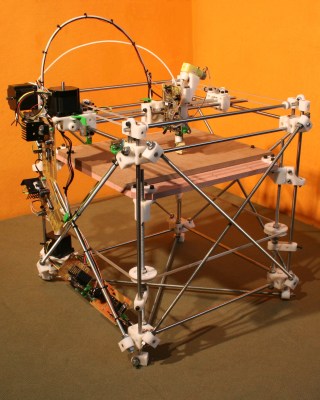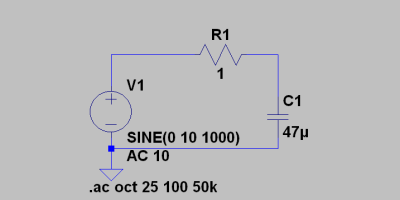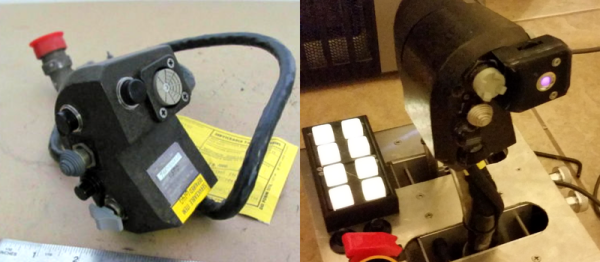We recently posted a three-part series about using LTSpice to simulate electronic circuits (one, two, three). You might have found yourself wondering: Can you really simulate practical designs with the program? This quick analysis of [QRP Gaijin’s] minimalist regenerative receiver says “yes”.
Day: March 2, 2016
Repairing A Sony Dream Machine
Have you ever fancied a gadget but been put off by what seems like an excessive price? [leadacid44] did just that back in 2009, in his case the gadget in question was a Sony Dream Machine ICF-CL75iP. It’s an alarm clock radio, albeit a very fancy one featuring an iPod dock, SD card slot, and an electronic photo frame. Back then it was just too expensive, but in 2016 [leadacid44] spotted one on an auction site for pennies, and so snapped it up.
Of course, with something cheap there is so often a catch. In the case of this Dream Machine, it would not keep time — something pretty important in a clock. But rather than throw it on the “Hack later” pile, [leadacid44] decided to investigate, and turned up a surprising culprit. The glue Sony had used to secure the timing crystal in 2009 had become conductive with age, causing the oscillator to stop oscillating. A simple fix involving a bit of glue removal and a touch of resoldering, and the clock was back with us.
This was a very simple repair when the problem was diagnosed, but it tells us something about electronic product design, and about quality control. Sony have spent a very long time building a reputation for quality manufacture, and it is likely the Dream Machine was built with their full attention to detail. It is highly unlikely that the Sony engineers chose their crystal glue in the knowledge it would break down, after all the company is likely to make far more money selling a new TV or phone to a satisfied alarm clock owner than it is by selling them a new alarm clock. Instead it tells us that even Sony with a legendary attention to quality control can be caught out by unexpected component failures, and that as engineers we should always expect the unexpected.
So [leadacid44] has a new alarm clock, and presumably now always wakes up on time. It’s interesting to look at the Dream Machine from another perspective, to compare what was hot in 2009 with what you might see now. The Apple Dock connector for instance, or the full-size SD card. Both of which are now becoming historical curiosities, even though this device is not much more than six years old.
Over the years we’ve featured a lot of clocks, and even the odd clock radio. But this isn’t really about clock radios, and with that out of the way we’ve certainly featured a few Sony hacks.
When Life Gives You An F-15 Throttle Grip Make A Cool Joystick
We’re not certain where [NoPleaseDont] got an F-15 Throttle Grip, but it would certainly be a waste not to make something cool out of one. The F-15 is a twin engine air superiority fighter, and in it’s niche, it is one of the most successful ever made. We imagine this makes it a popular choice in air simulators.
Equipped with his successful scrounge [NoPleaseDont] decided to build a full HOTAS, Hands On Throttle and Stick, joystick. He started by taking apart the throttle grip. As each layer was pulled a part, we were pleased to see the reassuring infestation of quality control stamps you’d expect to find on the input of a 26million dollar machine. The pinouts were presumably taken and the handle was reassembled. After that, a lot of custom sheet metal parts, 3D prints, and clever bracketry came together to form the frame of the joystick.
Finally came the electronics. Many of the photos were too blurry to decode, but at minimum a Teensy and custom LED control board is involved. The frame got a few additional buttons and control panels added.
The resulting joystick has a great history, and more buttons than we can guess the purpose of.
Google Is Building A 100kW Radio Transmitter At A Spaceport And No One Knows Why
You can find the funniest things in public government documents. There’s always ample evidence your local congress critter is working against the interests of their constituency, nation, and industry controlled by the commission they’re chairperson of. Rarely, though, do you find something surprising, and rarer still does it portend some sort of experiments conducted by Google at a spaceport in New Mexico.
In a publication released last week, Google asked the FCC to treat some information relating to radio experiments as confidential. These experiments involve highly directional and therefore high power transmissions at 2.5 GHz, 5.8GHz, 24GHz, 71-76GHz, and 81-86GHz. These experiments will take place at Spaceport America, a 12,000 foot runway in the middle of New Mexico occasionally used by SpaceX, Virgin Galactic, and now Google.
For the most part, this document only tells the FCC that Google won’t be causing harmful interference in their radio experiments. There few other details, save for what bands and transmitters Google will be using and an experimental radio license call sign (WI9XZE) that doesn’t show up in the FCC database.
Of the few details listed in the documents, one thing does pop out as exceptionally odd: a 70-80 GHz transmitter with an effective radiated power (ERP) 96,411 W. That’s close enough to 100 kilowatts to call it as such. This is the maximum effective radiated power of the highest power FM stations in the US, but radio stations are omnidirectional, whereas Google is using very high gain antennas with a beam width of less than half a degree. The actual power output of this transmitter is a mere half watt.
The best guess for what Google is doing out in the New Mexico desert is Project Skybender, a project to use millimeter waves to bring faster Internet to everyone. There aren’t many details, but there is a lot of speculation ranging from application in low Earth orbit to something with Google Loon.
Getting It Right By Getting It Wrong: RepRap And The Evolution Of 3D Printing
The beginning of the DIY 3D printing movement was a heady time. There was a vision of a post-scarcity world in which everything could and would be made at home, for free. Printers printing other printers would ensure the exponential growth that would put a 3D printer in every home. As it says on the front page: “RepRap is humanity’s first general-purpose self-replicating manufacturing machine.” Well, kinda.

Just to set the record straight, I love the RepRap project. My hackerspace put our funds together to build one of the first few Darwins in the US: Zach “Hoeken” came down and delivered the cut-acrylic pieces in person. I have, sitting on my desk, a Prusa Mendel with 3D parts printed by Joseph Prusa himself, and I spent a fantastic weekend with him and Kliment Yanev (author of Pronterface) putting it together. Most everyone I’ve met in the RepRap community has been awesome, giving, and talented. The overarching goal of RepRap — getting 3D printers in as many peoples’ hands as possible — is worthy.
But one foundational RepRap idea(l) is wrong, and unfortunately it’s in the name: replication. The original plan was that RepRap printers would print other printers and soon everyone on Earth would have one. In reality, an infinitesimal percentage of RepRap owners print other printers, and the cost of a mass-produced, commercial RepRap spinoff is much less than it would cost me to print you one and source the parts. Because of economies of scale, replicating 3D printers one at a time is just wasteful. Five years ago, this was a controversial stance in the community.
On the other hand, the openness of the RepRap community has fostered great advances in the state of the DIY 3D printing art. Printers haven’t reproduced like wildfire, but ideas and designs have. It’s time to look back on the ideal of literal replication and realize that the replication of designs, building methods, and the software that drives the RepRap project is its great success. It’s the Open Hardware, smarty! A corollary of this shift in thought is to use whatever materials are at hand that make experimentation with new designs as easy as possible, including embracing cheap mass-produced machines as a first step. The number of RepRaps may never grow exponentially, but the quality and number of RepRap designs can.
Continue reading “Getting It Right By Getting It Wrong: RepRap And The Evolution Of 3D Printing”
Converting An Electric Scooter To Lithium Batteries And Disabling The Safeties
There’s a bunch of different electric scooters available nowadays, including those hoverboards that keep catching fire. [TK] had an older Razor E300 that uses lead acid batteries. After getting tired of the low speeds and 12 hour charge times, [TK] decided it was time to swap for lithium batteries.
The new batteries were sourced from a Ryobi drill. Each provides 18 V, giving 36 V in series. The original batteries only ran at 24 V, which caused some issues with the motor controller. It refused to start up with the higher voltage. The solution: disable the safety shutdown relay on the motor controller by bridging it with a wire.
With the voltage issue sorted out, it was time for the current limit to be modified. This motor controller uses a TI TL494 to generate the PWM waveforms that drive a MOSFET to provide variable power to the motor. Cutting the trace to the TL494’s current sense pin removed the current limit all together.
We’re not saying it’s advisable to disable all current and voltage limits on your scooter, but it seems to be working out for [TK]. The $200 scooter now does 28 km/h, up from 22 km/h and charges much faster. With gearing mods, he’s hoping to eke out some more performance.
After the break, the full conversion video.
Continue reading “Converting An Electric Scooter To Lithium Batteries And Disabling The Safeties”
Transforming Spice
Spice is a circuit simulator that you should have in your toolbox. While a simulator can’t tell you everything, it will often give you valuable insight into the way your circuit behaves, before you’ve even built it. In the first installment of this three-part series, I looked at LTSpice and did a quick video walkthrough of a DC circuit. In the second, I examined two other parts of Spice: parameter sweeps and AC circuits. In this final installment, I want to talk a bit more about real-world component performance and also look at modeling transformers.
Recap
 Last time we looked at a low pass filter, but it wasn’t practical because the components were too perfect. Only in simulation do voltage sources and wires have zero resistance. There was no load resistance either, which is unlikely. Even an oscilloscope probe will load the circuit a little.
Last time we looked at a low pass filter, but it wasn’t practical because the components were too perfect. Only in simulation do voltage sources and wires have zero resistance. There was no load resistance either, which is unlikely. Even an oscilloscope probe will load the circuit a little.
The resulting AC analysis showed a nice filter response that was flat to about 1 kHz and then started roll off as the frequency increased. Suppose the source had an 8 ohm series resistor. How does that change the circuit response?
















